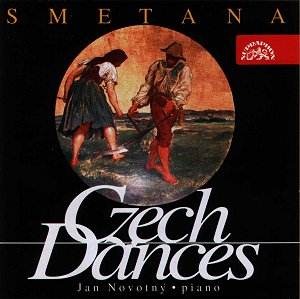This enterprising Supraphon disc couples early and
late solo piano music by Smetana; his Opus 1 (though not truly his first
efforts at composition) and his last piano pieces, written five years
before his death (around the same time he was completing his famous
Má Vlast). Both groups are well worth the listener's attention
and the Czech Dances, in particular, ought to be essential listening
for anyone who is interested in the origins and ongoing influence of
folk idioms in Czech classical music, through
Dvořák and Janáček to Martinů. The rhythmic invention
and inherent tunefulness may also appeal to devotees of Grieg's solo
piano output.
Characteristic Pieces is quite a commonly used
sobriquet for many a composer's early efforts, which often turn out,
in retrospect, to be anything but characteristic. However, although
the influence of Czech folk music and dance, so apparent in the later
work is, not surprisingly, given its more formative nature, harder to
detect in the Opus 1, the music does sometimes hint strongly
at future direction (try The Shepherdess, for instance). The
pieces were dedicated to Liszt and the booklet note explains in detail
how he was instrumental in facilitating their publication. He was clearly
impressed by the pieces, originally titled in French, and probably helped
Smetana on his way quite considerably, if more by influential rather
than financial patronage.
The Czech Dances are divided into four sections:-
two solo dances (including a Furiant - the booklet provides an
explanation of the French/Napoleonic origins of the term which is both
enlightening and entertaining), four "men's" dances (the gentle Oats,
The Bear, The Little Onion and the bagpipe imitating Stamp
Dance), two "maiden" dances (including
a graceful lament) and a closing pair of group dances. All share the
distinction of being truly memorable, either rhythmically, melodically
or often both, and it isn't difficult to see how certain aspects of
the music of Dvořák and Janáček were informed by such
antecedents. The dances conform to Smetana's habit of using thematic
pairs, contrasting but complementary pieces, as in the symphonic cycle
Má Vlast, and also employ frequent changes of time signature
(known as "confounds"). The latter, in particular, makes the music sound
more modern (or ancient?) than it actually is and there are even passages
reminiscent of such an ostensibly unrelated figure as Percy Grainger!
Rudolf Firkušný's 1950s recordings of the Czech
Dances were, like his Janáček,
very special, but this performance and recording offer an advocacy of
this wonderfully open hearted music that is not so far removed from
that accolade. Recommended.
Neil Horner


